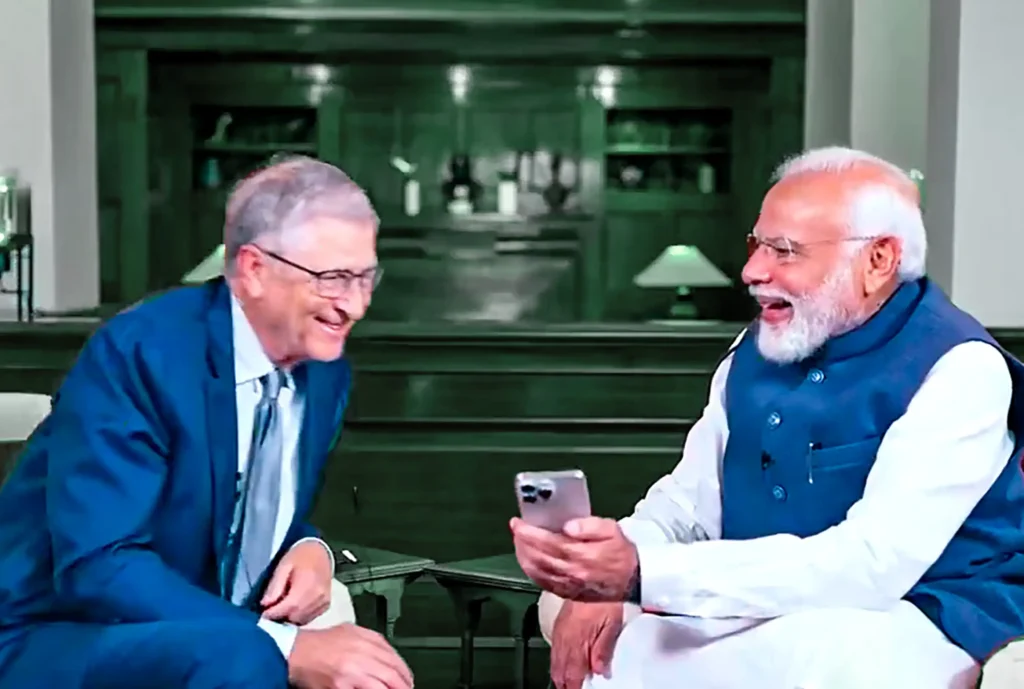In a recent conversation with Microsoft co-founder Bill Gates, Prime Minister Narendra Modi said, “India is a pioneer in leveraging technology to better the lives of its citizens.” Here are some of the key highlights from their discussion:
Emphasizing Training Before Access- PM MODI
PM Modi, on his part, had stressed the point that people need to be widely trained before allowing them to have access to AI technologies so that there was no possibility of misuse. He indicated the importance of clear watermarks over AI-generated content, which was a matter of curbing fake news and information that are likely to mislead the public or manipulate them.
“If such good technology is given into the hands of people without proper training, then it’s likely to be misused,” said Modi. “I had very strongly raised the need for beginning the process of clearing watermarks on AI-generated content so that nobody is misled.
“In a democratic country, anyone can use deepfake. Its very important people should understand be it deepfake or shallow fake, they are AI-generated. We’ll have to think of some dos and don’ts,” he added.
Addressing the Threat of Deepfake
The prime minister warned of the menace deepfake content could bring and urged for clear lines in differentiating between authentic content and AI creation. Prime Minister Modi has warned that the deep fake video using his voice could lead to chaos and affect the control of any spread of false information.

“They may misuse my voice, voice of any person speaking right now, to misguide people into first causing huge turmoil, for example.” Speaking on the deepfake phenomenon, PM Modi said, “It is important to acknowledge that deepfake content is AI-generated and say its source.
Caution Against Reckless Deployment
“The prime minister warned that the deployment of AI should not be used recklessly”, and he warned against perceiving it as a ‘magic tool.’ He stressed hard work and responsibility in the use of AI technologies for avoiding the most basic, fundamental layers of grave injustice and harm to society.
“If we use AI as a magical tool, then maybe we can deliver it as great injustice. If AI is resorted to out of laziness, then it is the wrong path,” quipped Modi, making a pitch for a human versus AI chatbot, like ChatGPT.
Insights from Bill Gates
Bill Gates echoed similar sentiments to what Modi said; he recognized that AI has the dynamism that it brings to the table for development and the dilemmas that it puts on the same table. He underscored one very important necessity for the improvement of the accuracy and functionality, but not replacement of the users, by stressing that the AI should play an aiding tool rather than the substitute of human decision-making.

“And I think it’s pretty early days in AI. I think everybody’s using it. On the same day, you’re surprised at how good it is, and you’re also surprised at how bad it is. It will do things you think are hard, and then it will fail to do some things you think are easy. So, it’s like me starting a journey here in Hyderabad. It’s such a nice occasion as Microsoft celebrates 25 years in the country, and that has been such a great experience.
So, really, I was challenging the team there: ‘Hey, let’s increase the level of accuracy.’ And for now, it’s like a co-pilot. It suggests some things, but the final decision about the medicine or the letter that you want to write, we still have to review that, although maybe it gives us a little more creativity, a little more productivity. You know, it seems like AI is a huge opportunity, but there are some challenges that come with that.” Gates said
FAQS
India’s AI strategy focuses on using AI technology to encourage social innovation, social progress, and economic success. The government promotes ethical AI methods and joint study projects while promoting the deployment of AI across multiple industries, including healthcare, agriculture, education, and governance.
India promotes AI’s role in promoting innovation and economic growth while realizing the technology’s innovative potential in a variety of industries, including healthcare, agriculture, and finance. With policies that support research, development, and ethical use of AI, the government encourages the adoption of AI.
India is focusing on upskilling and retraining efforts to provide workers with AI-related skills, promoting the growth of jobs in AI-enabled sectors while solving possible issues with job displacement.
Conclusion
India still negotiates the confusing details of AI adoption, and PM Modi’s stress on training, regulation, and responsible deployment is really bringing a pragmatist approach to harnessing the potential that AI comes with its associated risks. Thus, facilitating increased collaboration among policymakers, technologists, and civil society can place India in the vanguard of a balanced and ethical integration of AI in society.










